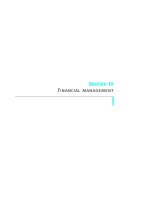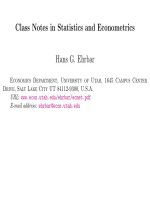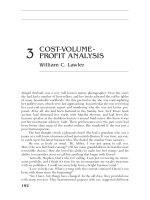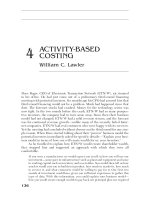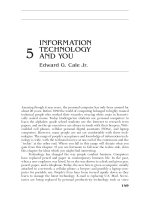PORTABLE MBA IN FINANCE AND ACCOUNTING CHAPTER 1 pdf
Bạn đang xem bản rút gọn của tài liệu. Xem và tải ngay bản đầy đủ của tài liệu tại đây (329.27 KB, 47 trang )
PORTABLE
MBA
in
FINANCE AND
ACCOUNTING
The Portable MBA Series
The Portable MBA, Third Edition, Robert Bruner, Mark Eaker, R. Edward
Freeman, Robert Spekman and Elizabeth Olmsted Teisberg
The Portable MBA Desk Reference, Second Edition, Nitin Nohria
The Portable MBA in Economics, Philip K.Y. Young
The Portable MBA in Entrepreneurship, Second Edition, William D. Bygrave
The Portable MBA in Entrepreneurship Case Studies, William D. Bygrave
The Portable MBA in Finance and Accounting, Third Edition, John Leslie
Livingstone and Theodore Grossman
The Portable MBA in Investment, Peter L. Bernstein
The Portable MBA in Management, First Edition, Allan Cohen
The Portable MBA in Market-Driven Management: Using the New
Marketing Concept to Create a Customer-Oriented Company,
Frederick E. Webster
The Portable MBA in Marketing, Second Edition, Alexander Hiam and
Charles Schewe
The Portable MBA in New Product Development: Managing and Forecasting
for Strategic Success, Robert J. Thomas
The Portable MBA in Psychology for Leaders, Dean Tjosvold
The Portable MBA in Real-Time Strategy: Improvising Team-Based Planning
for a Fast-Changing World, Lee Tom Perry, Randall G. Stott, and
W. Norman Smallwood
The Portable MBA in Strategy, Second Edition, Liam Fahey and
Robert Randall
The Portable MBA in Total Quality Management: Strategies and Techniques
Proven at Today’s Most Successful Companies, Stephen George and
Arnold Weimerskirch
Forthcoming:
The Portable MBA in Management, Second Edition, Allan Cohen
PORTABLE
MBA
in
FINANCE AND
ACCOUNTING
THIRD EDITION
Edited by
John Leslie Livingstone
and
Theodore Grossman
John Wiley & Sons, Inc.
Copyright © 2002 by John Wiley & Sons, Inc., New York. All rights reserved.
No part of this publication may be reproduced, stored in a retrieval system or transmitted in any form
or by any means, electronic, mechanical, photocopying, recording, scanning or otherwise, except as
permitted under Section 107 or 108 of the 1976 United States Copyright Act, without either the prior
written permission of the Publisher, or authorization through payment of the appropriate per-copy
fee to the Copyright Clearance Center, 222 Rosewood Drive, Danvers, MA 01923, (978) 750-8400,
fax (978) 750-4744. Requests to the Publisher for permission should be addressed to the Permissions
Department, John Wiley & Sons, Inc., 605 Third Avenue, New York, NY 10158-0012, (212) 850-6011,
fax (212) 850-6008, E-Mail:
This publication is designed to provide accurate and authoritative information in regard to the subject
matter covered. It is sold with the understanding that the publisher is not engaged in rendering
professional services. If professional advice or other expert assistance is required, the services of a
competent professional person should be sought.
This title is also available in print as Bookz ISBN 0-471-06185-9. Some content that appears in the print
version of this book may not be available in this electronic edition.
For more information about Wiley products, visit our web site at www.Wiley.com
v
Preface
Do you know how to accomplish these important business tasks?
• Understand financial statements.
• Measure liquidity of a business.
• Analyze business profitability.
• Differentiate between regular income and extraordinary items.
• Predict future bankruptcy for an enterprise.
• Prepare a budget.
• Do a break-even analysis.
• Measure productivity.
• Figure out return on investment.
• Compute the cost of capital.
• Put together a business plan.
• Legitimately minimize income taxes payable by you or your business.
• Decide whether your business should be a limited partnership, a C or S
corporation, or some other type of entity.
• Take your company public.
• Manage foreign currency exposure.
• Evaluate a merger or acquisition target.
• Serve as a director of a corporation.
• Build a successful e-business.
• Understand and use financial derivatives.
• Use information technology for competitive advantage.
• Value a business.
These are some of the key topics explained in this book. It is a book de-
signed to help you learn the basics in finance and accounting, without incur-
ring the considerable time and expense of a formal MBA program.
vi Preface
The first edition of this book was published in 1992, and the second edi-
tion in 1997. Both editions, hardback and paperback, have been highly success-
ful and have sold many, many copies. In addition, the book has been translated
into Chinese (Cantonese and Mandarin), French, Indonesian, Portuguese, and
Spanish. We are delighted that so many readers in various countries have found
this book useful. Now, the entire book has been updated for the third edition.
The following new chapters have been added:
• Chapter 1: Using Financial Statements
• Chapter 3: Cost-Volume-Profit Analysis
• Chapter 5: Information Technology and You
• Chapter 6: Forecasts and Budgets
• Chapter 9: The Business Plan
• Chapter 10: Planning Capital Expenditure
• Chapter 17: Profitable Growth by Acquisition
• Chapter 18: Business Valuation
Also, there are eight new authors, substantial revisions of four chapters
and complete updates of all remaining chapters. The book consists of valu-
able, practical how-to-do-it information, applicable to an entire range of busi-
nesses, from the smallest startup to the largest corporations in the world.
Each chapter of the book has been written by an outstanding expert in the
subject matter of that particular chapter. Some of these experts are full-time
practitioners in the real world, and others are part-time consultants who also
serve as business school professors. Most of these professors are on the fac-
ulty of Babson College, which is famous for its major contributions to the
field of entrepreneurship and which, year after year, is at the top of the an-
nual list of leading independent business schools compiled by U.S. News and
World Report.
This book can be read, and reread, with a great deal of profit. Also, it can
be kept handy on a nearby shelf in order to pull it down and look up answers to
questions as they occur. Further, this book will help you to work with finance
and accounting professionals on their own turf and in their own jargon. You
will know what questions to ask, and you will better understand the answers
you receive without being confused or intimidated.
Who can benefit from this book? Many different people, such as:
• Managers wishing to improve their business skills.
• Engineers, chemists, scientists and other technical specialists preparing
to take on increased management responsibilities.
• People already operating their own businesses, or thinking of doing so.
• Business people in nonfinancial positions who want to be better versed in
financial matters.
• BBA or MBA alumni who want a refresher in finance and accounting.
Preface vii
• People in many walks of life who need to understand more about financial
matters.
Whether you are in one, some, or even none of the above categories, you
will find much of value to you in this book, and the book is reader friendly.
Frankly, most finance and accounting books are technically complex, boringly
detailed, or just plain dull. This book emphasizes clarity to nonfinancial read-
ers, using many helpful examples and a bright, interesting style of writing.
Learn, and enjoy!
J
OHN
L
ESLIE
L
IVINGSTONE
T
HEODORE
G
ROSSMAN
ix
Acknowledgments
A book like this results only from the contributions of many talented people.
We would like to thank the chapter authors that make up this book for their
clear and informative explanations of the powerful concepts and tools of fi-
nance and accounting. In this world of technology and the Internet, while most
of the underlying concepts remain fixed, the applications are ever changing,
requiring the authors to constantly rededicate themselves to their professions.
Our deepest appreciation goes to our wives, Trudy Livingstone and Ruth
Grossman, and to our children Robert Livingstone, Aaron and Melissa Gross-
man, and Michael Grossman. They provide the daily inspiration to perform our
work and to have undertaken this project.
J. L. L.
T. G.
xi
Contents
Preface v
Acknowledgments ix
PART ONE UNDERSTANDING THE NUMBERS 1
1. Using Financial Statements 3
John Leslie Livingstone
2. Analyzing Business Earnings 35
Eugene E. Comiskey and Charles W. Mulford
3. Cost-Volume-Profit Analysis 102
William C. Lawler
4. Activity-Based Costing 126
William C. Lawler
5. Information Technology and You 149
Edward G. Cale Jr.
6. Forecasts and Budgets 173
Robert Halsey
7. Measuring Productivity 199
Michael F. van Breda
xii Contents
PART TWO PLANNING AND FORECASTING 223
8. Choosing a Business Form 225
Richard P. Mandel
9. The Business Plan 260
Andrew Zacharakis
10. Planning Capital Expenditure 291
Steven P. Feinstein
11. Taxes and Business Decisions 314
Richard P. Mandel
12. Global Finance 353
Eugene E. Comiskey and Charles W. Mulford
13. Financial Management of Risks 423
Steven P. Feinstein
PART THREE MAKING KEY
STR ATEGIC DECISIONS 457
14. Going Public 459
Stephen M. Honig
15. The Board of Directors 510
Charles A. Anderson and Robert N. Anthony
16. Information Technology and the Firm 536
Theodore Grossman
17. Profitable Growth by Acquisition 561
Richard T. Bliss
18. Business Valuation 593
Michael A. Crain
Glossary 626
About the Authors 643
Index 649
PART ONE
UNDERSTANDING
THE NUMBERS
3
1
USING FINANCIAL
STATEMENTS
John Leslie Livingstone
WHAT ARE FINANCIAL STATEMENTS? A CASE STUDY
Pat was applying for a bank loan to start her new business, Nutrivite, a retail
store selling nutritional supplements, vitamins, and herbal remedies. She de-
scribed her concept to Kim, a loan officer at the bank.
Kim: How much money will you need to get started?
Pat: I estimate $80,000 for the beginning inventory, plus $36,000 for store
signs, shelves, fixtures, counters, and cash registers, plus $24,000 working
capital to cover operating expenses for about two months. That’s a total of
$140,000 for the startup.
Kim: How are you planning to finance the investment of the $140,000?
Pat: I can put in $100,000 from my savings, and I’d like to borrow the remain-
ing $40,000 from the bank.
Kim: Suppose the bank lends you $40,000 on a one-year note, at 15% interest,
secured by a lien on the inventory. Let’s put together projected financial
statements from the figures you gave me. Your beginning balance sheet
would look like what you see on my computer screen:
4 Understanding the Numbers
Nutrivite
Projected Balance Sheet as of January 1, 200X
Assets Liabilities and Equity
Cash $ 24,000 Bank loan $ 40,000
Inventory 80,000
Current assets 104,000 Current liabilities 40,000
Fixed assets: Equity:
Equipment 36,000 Owner capital 100,000
Total assets $140,000 Liabilities and equity $140,000
The left side shows Nutrivite’s investment in assets. It classifies the as-
sets into “current” (which means turning into cash in a year or less) and
“noncurrent” (not turning into cash within a year). The right side shows how
the assets are to be financed: partly by the bank loan and partly by your eq-
uity as the owner.
Pat: Now I see why it’s called a “balance sheet.” The money invested in assets
must equal the financing available—its like the two sides of a coin. Also, I
see why the assets and liabilities are classified as “current” and “noncur-
rent”—the bank wants to see if the assets turning into cash in a year or less
will provide enough cash to repay the one-year bank loan. Well, in a year
there should be cash of $104,000. That’s enough cash to pay off more than
twice the $40,000 amount of the loan. I guess that guarantees approval of
my loan!
Kim: We’re not quite there yet. We need some more information. First, tell
me, how much do you expect your operating expenses will be?
Pat: For year 1, I estimate as follows:
Store rent $36,000
Phone and utilities 14,400
Assistants’ salaries 40,000
Interest on the loan 6,000 (15% on $40,000)
Total $96,400
Kim: We also have to consider depreciation on the store equipment. It proba-
bly has a useful life of 10 years. So each year it depreciates by 10% of its cost
of $36,000. That’s $3,600 a year for depreciation. So operating expenses
must be increased by $3,600 a year, from $96,400 to $100,000. Now, moving
on, how much do you think your sales will be this year?
Pat: I’m confident that sales will be $720,000 or even a little better. The
wholesale cost of the items sold will be $480,000, giving a markup of
$240,000—which is 33
1
⁄
3% on the projected sales of $720,000.
Using Financial Statements 5
Kim: Excellent! Let’s organize this information into a projected income state-
ment. We start with the sales, then deduct the cost of the items sold to ar-
rive at the gross profit. From the gross profit we deduct your operating
expenses, giving us the income before taxes. Finally we deduct the income
tax expense in order to get the famous “bottom line,” which is the net in-
come. Here is the projected income statement shown on my computer
screen:
Nutrivite
Projected Income Statement for the
Year Ending December 31, 200X
Sales $720,000
Less cost of goods sold 480,000
Gross profit 240,000
Less expenses
Salaries $ 40,000
Rent 36,000
Phone and utilities 14,400
Depreciation 3,600
Interest 6,000 100,000
Income before taxes 140,000
Income tax expense (40%) 56,000
Net income $ 84,000
Pat, this looks very good for your first year in a new business. Many
business startups find it difficult to earn income in their first year. They do
well just to limit their losses and stay in business. Of course, I’ll need to care-
fully review all your sales and expense projections with you, in order to
make sure that they are realistic. But first, do you have any questions about
the projected income statement?
Pat: I understand the general idea. But what does “gross profit” mean?
Kim:
It’s the usual accounting term for sales less the amount that your suppli-
ers charged you for the goods that you sold to your customers. In other words,
it represents your markup from the wholesale cost you paid for goods and the
price for which you sold those goods to your customers. It is called “gross
profit” because your operating expenses have to be deducted from it. In
accounting, the word gross means “before deductions.” For example “gross
sales” means sales before deducting goods returned by customers. Sales after
deducting goods returned by customers are referred to as “net sales.” In ac-
counting, the word net means “after deductions.” So “gross profit” means in-
come before deducting operating expenses. By the same token, “net income”
means income after deducting operating expenses and income taxes. Now,
moving along, we are ready to figure out your projected balance sheet at the
6 Understanding the Numbers
end of your first year in business. But first I need to ask you how much cash
you plan to draw out of the business as your compensation?
Pat: My present job pays $76,000 a year. I’d like to keep the same standard of
compensation in my new business this coming year.
Kim: Let’s see how that works out after we’ve completed the projected bal-
ance sheet at the end of year 1. Here it is on my computer screen:
Nutrivite
Projected Balance Sheet as of December 31, 200X
Assets Liabilities and Equity
Cash $ 35,600 Bank loan $ 40,000
Inventory 80,000
Current assets 115,600 Current liabilities 40,000
Fixed assets: Equity:
Equipment $36,000 Capital: Jan 1 100,000
Less depreciation 3,600 Add net income 84,000
Net equipment $32,400 32,400 Less drawings (76,000)
Capital: Dec 31 108,000
Total assets $148,000 Liabilities and equity $148,000
Let’s go over this balance sheet together, Pat. It has changed compared
to the balance sheet as of January 1. On the Liabilities and Equity side of
the balance sheet, the Net Income of $84,000 has increased Capital to
$184,000 (because earning income adds to the owner’s Capital), and de-
ducting Drawings of $76,000 has reduced Capital to $108,000 (because
Drawings take Capital out of the business). On the asset side, notice that the
Equipment now has a year of depreciation deducted, which writes it down
from the original $36,000 to a net (there’s that word net again) $32,400 after
depreciation. The Equipment had an expected useful life of 10 years, now
reduced to a remaining life of 9 years. Last but not least, notice that the
Cash has increased by $11,600 from $24,000 at the beginning of the year to
$35,600 at year-end. This leads to a problem: The Bank Loan of $40,000 is
due for repayment on December 31. But there is only $35,600 in Cash avail-
able on December 31. How can the Loan be paid off when there is not
enough Cash to do so?
Pat: I see the problem. But I think it’s bigger than just paying off the loan.
The business will also need to keep about $25,000 cash on hand to cover two
months operating expenses and income taxes. So, with $40,000 to repay the
loan plus $25,000 for operating expenses, the cash requirements add up to
$65,000. But there is only $35,600 cash on hand. This leaves a cash shortage
of almost $30,000 ($65,000 less $35,600). Do you think that will force me to
Using Financial Statements 7
cut down my drawings by $30,000, from $76,000 to $45,000? Here I am
opening my own business, and it looks as if I have to go back to what I was
earning five years ago!
Kim: That’s one way to do it. But here’s another way that you might like bet-
ter. After your suppliers get to know you and do business with you for a few
months, you can ask them to open credit accounts for Nutrivite. If you get
the customary 30-day credit terms, then your suppliers will be financing one
month’s inventory. That amounts to one-twelfth of your $480,000 annual
cost of goods sold, or $40,000. This $40,000 will more than cover the cash
shortage of $30,000.
Pat: That’s a perfect solution! Now, can we see how the balance sheet would
look in this case?
Kim: Sure. When you pay off the Bank Loan, it vanishes from the balance
sheet. It is replaced by Accounts Payable of $40,000. Then the balance sheet
looks like this:
Nutrivite
Projected Balance Sheet as of December 31, 200X
Assets Liabilities and Equity
Cash $ 35,600 Accounts payable $ 40,000
Inventory 80,000
Current assets 115,600 Current liabilities 40,000
Fixed assets: Equity:
Equipment $36,000 Capital: Jan 1 100,000
Less depreciation 3,600 Add net income 84,000
Net equipment $32,400 32,400 Less drawings (76,000)
Capital: Dec 31 108,000
Total assets $148,000 Liabilities and equity $148,000
Now the cash position looks a lot better. But it hasn’t been entirely
solved: There is still a gap between the Accounts Payable of $40,000 and the
Cash of $35,600. So you will need to cut your drawings by about $5,000 in
year 1. But that’s still much better than the cut of $30,000 that had seemed
necessary before. In year 2 the Bank Loan will be gone, so the interest ex-
pense of $6,000 will be saved. Then you can use $5,000 of this saving to re-
store your drawings back up to $76,000 again.
Pat: That’s good news. I’m beginning to see how useful projected financial
statements are for business planning. Can we look at the revised projected
balance sheet now?
Kim: Of course. Here it is:
8 Understanding the Numbers
Nutrivite
Projected Balance Sheet as of December 31, 200X
Assets Liabilities and Equity
Cash $ 40,600 Accounts payable $ 40,000
Inventory 80,000
Current assets 120,600 Current liabilities 40,000
Fixed assets: Equity:
Equipment $36,000 Capital: Jan 1 100,000
Less depreciation 3,600 Add net income 84,000
Net equipment $32,400 32,400 Less drawings (71,000)
Capital: Dec 31 113,000
Total assets $153,000 Liabilities and equity $153,000
As you can see, Cash is increased by $5,000 to $40,600—which is suffi-
cient to pay the Accounts Payable of $40,000. Drawings is decreased by
$5,000 to $71,000, which provided the $5,000 increase in Cash.
Pat: Thanks. That makes sense. I really appreciate everything you’ve taught
me about financial statements.
Kim: I’m happy to help. But there is one more financial statement to discuss.
Besides the balance sheet and income statement, a full set of financial state-
ments also includes a cash flow statement. Here is the projected cash flow
statement:
Nutrivite
Projected Cash Flow Statement for the
Year Ending December 31, 200X
Sources of Cash
From Operations:
Net income $ 84,000
Add depreciation 3,600
Add increase in current liabilities 40,000
Total cash from operations (a) $ 127,600
From Financing:
Drawings $ (71,000) Negative cash
Bank loan repaid (40,000) Negative cash
Net cash from financing (b) (111,000) Negative cash
Total sources of cash (a + b) $ 16,600
Using Financial Statements 9
Uses of Cash
Total uses of cash 0
Total sources less total uses of cash $ 16,600 Net cash increase
Add cash at beginning of year 24,000
Cash at end of year $ 40,600
Pat, do you have any questions about this Cash Flow Statement?
Pat: Actually, it makes sense to me. I realize that there are only two sources
that a business can tap in order to generate cash: internal (by earning in-
come) and external (by obtaining cash from outside sources, such as bank
loans). In our case the internal sources of cash are represented by the “Cash
from Operations” section of the Cash Flow Statement, and the external
sources are represented by the “Cash from Financing” section. It happens
that the “Cash from Financing” is negative because no additional outside fi-
nancing is received for the year 200X, but cash payments are incurred for
Drawings and for repayment of the Bank Loan. I also understand that there
are no “Uses of Cash” because no extra Equipment was acquired. In addi-
tion, I can see that the Total Sources of Cash less the Total Uses of Cash
must equal the Increase in Cash, which in turn is the Cash at the end of the
year less the Cash at the beginning of the year. But I am puzzled by the
“Cash from Operations” section of the Cash Flow Statement. I can under-
stand that earning income produces Cash. However why do we add back De-
preciation to the Net Income in order to calculate Cash from Operations?
Kim: This can be confusing, so let me explain. Certainly Net Income increases
Cash, but first an adjustment has to be made in order to convert Net Income
to a cash basis. Depreciation was deducted as an expense in figuring Net In-
come. So adding back depreciation to Net Income just reverses the charge
for depreciation expense. We back it out because depreciation is not a cash
outflow. Remember that depreciation represents just one year’s use of the
Equipment. The cash outflow for purchasing the Equipment was incurred
back when the Equipment was first acquired and amounted to $36,000. The
Equipment cost of $36,000 is spread out over the 10-year life of the Equip-
ment at the rate of $3,600 per year, which we call Depreciation expense. So
it would be double counting to recognize the $36,000 cash outflow for the
Equipment when it was originally acquired and then to recognize it a second
time when it shows up as Depreciation expense. We do not write a check to
pay for Depreciation each year, because it is not a cash outflow.
Pat: Thanks. Now I understand that Depreciation is not a cash outflow. But I
don’t see why we also added back the Increase in Current Liabilities to the
Net Income to calculate Cash from Operations. Can you explain that?
Kim: Of course. The increase in Current Liabilities is caused by an increase in
Accounts Payable. These Accounts Payable are amounts owed to our suppliers
10 Understanding the Numbers
for our purchases of goods for resale in our business. Purchasing goods for
resale from our suppliers on credit is not a cash outflow. The cash outflow
only occurs when the goods are actually paid for by writing out checks to our
suppliers. That is why we added back the Increase in Current Liabilities to
the Net Income in order to calculate Cash from Operations. In the future,
the Increase in Current Liabilities will, in fact, be paid in cash. But that will
take place in the future and is not a cash outflow in this year. Going back to
the Cash Flow Statement, notice that it ties in neatly with our balance sheet
amount for Cash. It shows how the Cash at the beginning of the year plus the
Net Cash Increase equals the Cash at the end of the year.
Pat: Now I get it. Am I right that you are going to review my projections and
then I’ll hear from you about my loan application?
Kim: Yes, I’ll be back to you in a few days. By the way, would you like a print-
out of the projected financial statements to take with you?
Pat: Yes, please. I really appreciate your putting them together and explaining
them to me. I picked up some financial skills that will be very useful to me
as an aspiring entrepreneur.
POINTS TO REMEMBER ABOUT
FINANCIAL STATEMENTS
When Pat arrived home, she carefully reviewed the projected financial state-
ments, then made notes about what she had learned.
1.
The basic form of the balance sheet is Assets = Liabilities + Owner Equity.
2. Assets are the expenditures made for items, such as Inventory and Equip-
ment, that are needed to operate the business. The Liabilities and Owner
Equity reflect the funds that financed the expenditures for the Assets.
3. Balance sheets show the financial position of a business at a given mo-
ment in time.
4. Balance sheets change as transactions are recorded.
5. Every transaction is an exchange, and both sides of each transaction are
recorded. For example, when a company obtains a bank loan, there is an
increase in the asset cash that is matched by an increase in a liability enti-
tled “Bank Loan.” When the loan is repaid, there is a decrease in cash
which is matched by a decrease in the Bank Loan liability. After every
transaction, the balance sheet stays in balance.
6. Income increases Owner Equity, and Drawings decrease Owner Equity.
7. The income statement shows how income for the period was earned.
8. The basic form of the income statement is:
a. Sales − Cost of Goods Sold = Gross Income.
b. Gross Income − Expenses = Net Income.
Using Financial Statements 11
9. The income statement is simply a detailed explanation of the increase in
Owner Equity represented by Net Income. It shows how the Owner Eq-
uity increased from the beginning of the year to the end of the year be-
cause of the Net Income.
10. Net Income contributes to Cash from Operations after it has been ad-
justed to a cash basis.
11. Not all expenses are cash outflows—for instance, Depreciation.
12. Changes in Current Assets (except Cash) and Current Liabilities are not
cash outflows nor inflows in the period under consideration. They repre-
sent future, not present, cash flows.
13. Cash can be generated internally by operations or externally from sources
such as lenders or equity investors.
14. The Cash Flow Statement is simply a detailed explanation of how cash at
the start developed into cash at the end by virtue of cash inflows, gener-
ated internally and externally, less cash outflows.
15. As previously noted:
a. The Income Statement is an elaboration of the change in Owner Eq-
uity in the Balance Sheet caused by earning income.
b. The Cash Flow Statement is an elaboration of the Balance-Sheet
change in beginning and ending Cash.
Therefore, all three financial statements are interrelated or, to use the
technical term, “articulated.” They are mutually consistent, and that is
why they are referred to as a “set” of financial statements. The three-
piece set consists of a balance sheet, income statement, and cash flow
statement.
16. A set of financial statements can convey much valuable information about
the enterprise to anyone who knows how to analyze them. This informa-
tion goes to the core of the organization’s business strategy and the effec-
tiveness of its management.
While Pat was making her notes, Kim was carefully analyzing the Nutriv-
ite projected financial statements in order to make her recommendation to the
bank’s loan committee about Nutrivite’s loan application. She paid special at-
tention to the Cash Flow Statement, keeping handy the bank’s guidelines on
cash flow analysis, which included the following issues:
• Is cash from operations positive? Is it growing over time? Is it keeping
pace with growth in sales? If not, why not?
• Are cash withdrawals by owners only a small portion of cash from opera-
tions? If owners’ cash withdrawals are a large share of cash from opera-
tions, then the business is conceivably being milked of cash and may not
be able to finance its future growth.
12 Understanding the Numbers
• Of the total sources of cash, how much is being internally generated by
operations versus obtained from outside sources? Normally wise busi-
nesses rely more on internally generated cash for growth than on external
financing.
• Of the outside financing, how much is derived from equity investors and
how much is borrowed? Normally, a business should rely more on equity
than debt financing.
• What kind of assets is the company acquiring with the cash being ex-
pended? Are these asset expenditures likely to be profitable? How long
will it take for these assets to repay their cost and then to earn a reason-
able return?
Kim reflected carefully on these issues and then finalized her recommen-
dation, which was to approve the loan. The bank’s loan committee accepted
Kim’s recommendation and even went further. They authorized Kim to tell Pat
that—if she met all her responsibilities in regard to the loan throughout the
year—the bank would renew the loan at the end of the year and even increase
the amount. Kim called Pat with the good news. Their conversation included
the following dialogue:
Kim: To renew the loan, the bank will ask you for new projected financial
statements for the subsequent year. Also, the loan agreement will require
you to submit financial statements for the year just past—that is, not pro-
jected but actual financial statements. The bank will require that these ac-
tual financial statements be reviewed by an independent CPA before you
submit them.
Pat: Let me be sure I understand: Projected financial statements are forward-
looking, whereas actual financial statements are backward looking, is that
correct?
Kim: Yes, that’s right.
Pat: Next, what is an independent CPA?
Kim: As you probably know, a CPA is a certified public accountant, a profes-
sional trained in finance and accounting and licensed by the state. Indepen-
dent means a CPA who is not an employee of yours or a relative. It means
someone in public practice in a CPA firm, someone who will likely make an
objective and unbiased evaluation of your financial statements.
Pat: And what does reviewed mean?
Kim: Good question. CPAs offer three levels of service relating to financial
statements:
• An audit is a thorough, in-depth examination of the financial statements
and test of the supporting records. The result is an audit report, which
states whether the financial statements are free of material misstate-
ments (whether caused by error or fraud). A “clean” audit report pro-
vides assurance that the financial statements are free of material
misstatements. A “modified” report gives no such assurance and is cause

